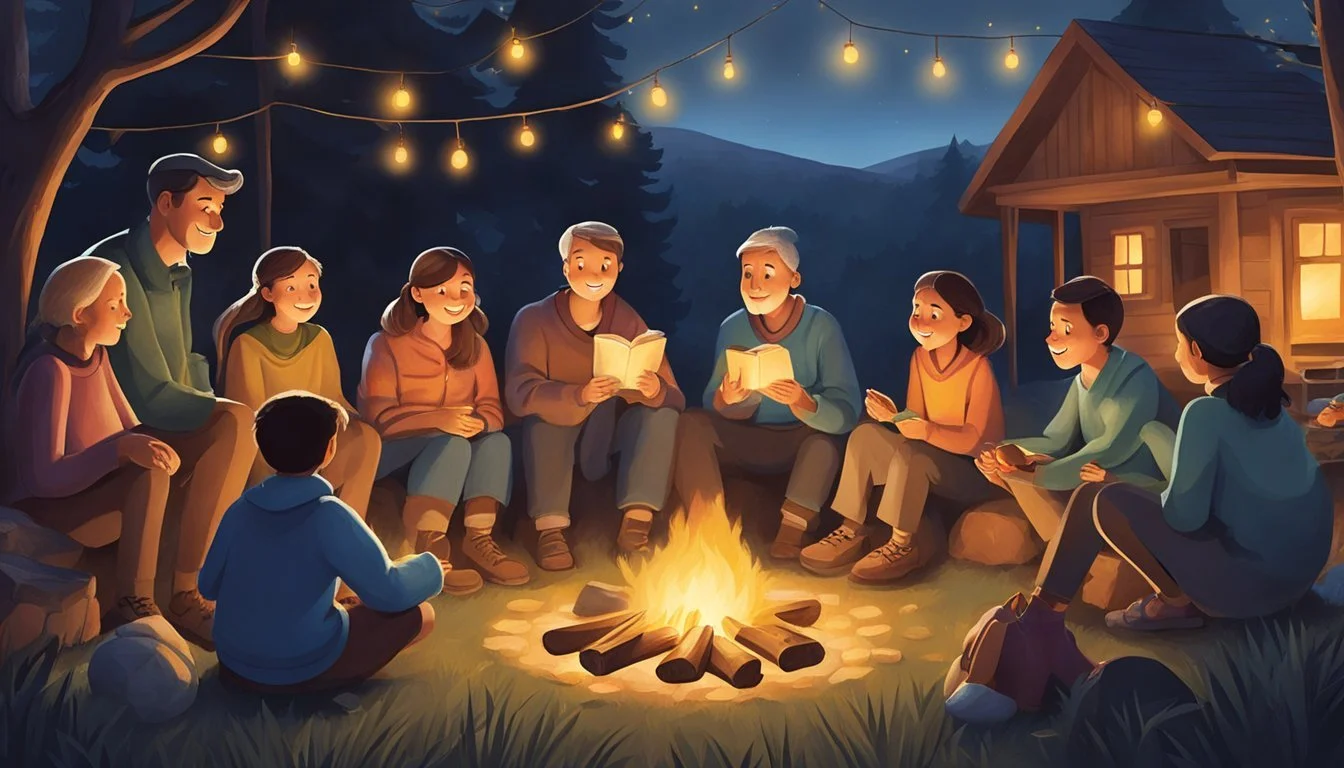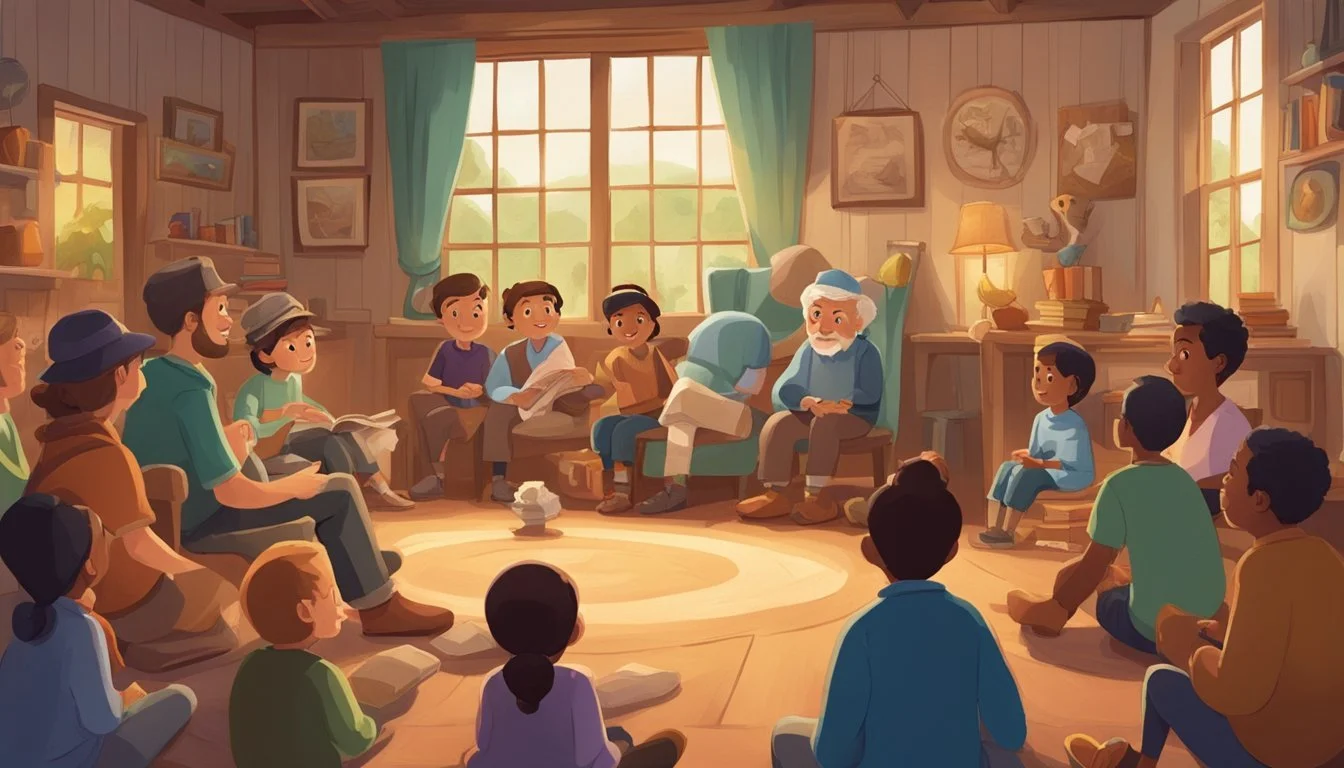Easter Storytelling
Enriching Family Gatherings with Ancestral Narratives and Lore
Easter, celebrated across various cultures and communities, is a holiday rich in storytelling and the recounting of history. It carries with it a tradition of passing down family narratives and folklore, interwoven with the central theme of renewal and hope which the season of spring brings. Storytelling during Easter, whether it revolves around the Biblical account of Jesus' death and resurrection or family histories and folk tales, serves as a powerful medium for sharing values, imparting lessons, and strengthening communal ties.
Folktales, in particular, have found a special place in Easter traditions, as families take this time to reconnect and share stories that have been carried through generations. These tales often vary greatly by culture, from the Native American narratives like "How Rabbit Got Long Ears," which teach valuable life lessons, to the Greek myths explaining the seasons, exemplified by "Persephone and the Seasons." Easter storytelling becomes an opportunity not just to entertain, but also to educate and preserve a rich heritage of oral history.
In modern times, even as the practice of gathering may change or adapt to online platforms, the essence of Easter storytelling remains the same. It's an expression of identity and a reflection on the past, encapsulated through the simple yet profound act of sharing stories. These stories, both sacred and secular, connect individuals to their families and communities, keeping the spirit of Easter alive and vibrant for all ages.
The Roots of Easter Storytelling
In exploring the roots of Easter storytelling, one uncovers the intertwining of ancient folklore and religious commemorations that mark the season's historical and cultural significance.
Historical Origins of Easter
Easter's historical origins trace back to the Christian commemoration of the Resurrection of Jesus Christ. This event, where Christians believe that Jesus rose from the dead three days after his Crucifixion, built the foundation for Easter as a principal festival in the Christian church.
Passover Alignment: While Easter primarily celebrates the Resurrection, its observance is often closely aligned with the Jewish holiday of Passover. This connection stems from the fact that Jesus’ Last Supper, which occurred just prior to his arrest and subsequent death, was a Passover Seder according to the Synoptic Gospels.
Lent and Holy Week: Preceding Easter, the 40-day period known as Lent encompasses acts of penance and fasting. Holy Week, the final week of Lent, intensively prepares believers for the remembrance of Jesus' suffering, death on the cross, and ultimately his resurrection.
Evolving Easter Traditions
Over the centuries, Easter traditions have evolved, incorporating various cultural elements.
Easter Eggs: Originating as a symbol of new life and resurrection, Easter eggs have become a staple of the holiday's modern representation. They are linked to pagan traditions of celebrating spring and to Christian practices of abstaining from eating eggs during Lent and then consuming them again at Easter.
Easter Bunny: The Easter Bunny, another symbol that has become synonymous with the holiday, is not found in the Bible but is believed to have been adopted from German folklore, where it was thought to deliver colorful eggs to well-behaved children.
Storytelling Practices: Family storytelling during Easter is not only about retelling the Passion of Christ but also about sharing family histories, especially considering the gathering of families during this time. These narratives often mix religious teachings with personal family stories, allowing the intergenerational transmission of moral and cultural values.
The Art of Sharing Stories
Easter, a time for renewal and family, provides a perfect backdrop for the sharing of stories that weave together personal histories and cultural folklore. Storytelling is a powerful means to foster love, improve understanding, and reinforce family bonds.
Family Narratives and Easter
Easter gatherings are ripe for the sharing of family narratives, becoming a tradition for many households. Parents and grandparents often take this opportunity to recount their childhood memories or stories passed down through generations. These narratives can enhance a sense of identity within the family and offer children a sense of continuity and belonging. They serve not just to entertain, but also to impart lessons and values that are important to the family's cultural and moral framework.
Importance in Family Dynamics:
Bonding: Sharing stories brings family members closer, creating a comfortable environment for dialogue and connection.
Education: Through tales of the past, children learn about their heritage and the experiences that shaped their family.
Incorporating Folktales and Legends
Folktales and legends play a significant role in preserving the culture and wisdom of a community. During Easter, these stories provide a colorful tapestry against which families can view their own histories. Incorporating such tales into family gatherings can enhance the celebratory mood, transporting listeners to different times and places, while also embedding a collective cultural identity.
Relevance to Easter:
Cultural Legends: Often tied to themes of hope and rebirth, aligning well with the essence of the holiday.
Moral Values: Folktales often carry messages that resonate with Easter's themes of forgiveness, sacrifice, and joy.
In utilizing both family stories and cultural tales, Easter becomes a time where the art of storytelling enriches the communal experience and nurtures the family's and community's legacy.
Engaging Various Age Groups
Easter storytelling is a vibrant tradition that can be tailored to suit different age groups, enriching the holiday experience through sharing family histories and folktales. It invites participation from everyone, creating a tapestry of tales that span generations.
Storytelling for Children and Adolescents
Children of varying ages, from preschool to high school, engage with stories differently. For the younger audience, such as preschool and middle school students, stories often include interactive activities. This could take the form of simple Easter crafts woven into the narrative, or imaginative prompts that encourage the children to invent new characters or plotlines. In doing so, storytelling becomes a creative and educational experience that can foster listening skills and cognitive development.
Easter storytelling for adolescents, particularly those in high school, can be more complex. It often prompts discussion and reflection, connecting the Easter narrative with relevant family history or community folklore. Parents and educators can encourage adolescents to share their interpretations or even write their own adaptations, turning listening into an active sharing session that builds their analytical and storytelling skills.
Adults and Easter Stories
For adults, Easter storytelling takes on a deeper dimension, becoming a means of cultural preservation and family bonding. It's a time when parents and other adult family members recount tales from past generations to younger family members or friends, engaging in a shared experience that strengthens community ties. The stories shared often provoke thoughtful discussion among adults and serve as a bridge for intergenerational connection, allowing older members to reflect on Easter traditions and changes over time. The activity transcends simple storytelling, moving into the realm of narrative as a method of maintaining family legacy and imparting values.
Easter Activities and Learning
Easter is a time for families to come together and engage in activities that foster learning and tradition. From crafting to storytelling, these activities serve as a way to pass down heritage, enhance vocabulary, and bring joy to the season for both children and adults.
Crafting and Easter Egg Hunts
Crafting provides a hands-on way for children to learn about Easter traditions and express their creativity. Families can involve children in making a set of Resurrection Eggs, which are decorated eggs with symbols inside representing different aspects of the Easter story. This activity encourages discussion and vocabulary enrichment as each egg prompts questions about the Easter narrative.
Easter Egg Hunt: A classic activity that can be both fun and educational. Families can organize Easter egg hunts in the backyard or within the community. This event not only provides excitement for children but also teaches them about the joy of discovery and the value of participating in a group.
Local events frequently include community-wide egg hunts, which often incorporate learning through play, such as matching games or treasure hunt-style clues that lead to eggs.
Music and Dramatic Renditions
Music plays a significant role in Easter celebrations. Families and communities come together to sing Easter hymns or songs that carry the messages of hope and renewal. Participating in musical activities can help children and adults alike learn through the powerful medium of song, cementing the story of Easter and its values in memory.
Performance: Dramatic renditions of the Easter story are another way to share and learn. Some families choose to put on plays or skits that recount the events leading up to Easter. This method of storytelling through performance can be particularly impactful, making the historical events more relatable and engaging for all ages. In addition to entertainment, it provides an opportunity for discussion and deeper understanding of cultural and spiritual lessons.
Through these activities, families and communities can ensure that the history, traditions, and meaning behind Easter are preserved and appreciated by the younger generations.
Spiritual Reflection and Discussion
Easter storytelling provides a platform for families to engage in spiritual reflection and discussion. These narratives often focus on fostering understanding and identity through the retelling of the Easter story.
Themes of Hope and Rebirth
The Easter story is rich with themes of hope and rebirth, pivotal elements that resonate through many family histories and folktales. Storytelling during Easter can illuminate these themes, drawing parallels between the scriptural accounts of Jesus' crucifixion and resurrection and the cyclical patterns in human experiences. Easter stories help individuals relate their personal journeys of growth and renewal to the larger narrative, reinforcing a sense of hope in the face of challenges.
Hope: Central to the Easter message is the unwavering belief in the potential for new beginnings.
Rebirth: Easter stories underscore the potential for transformation and reawakening in one's own life, mirroring nature's springtime renewal.
Lessons from the Easter Narrative
The lessons from the Easter narrative offer rich material for discussion and reflection, which can be profoundly influential in family storytelling. The crucifixion and resurrection of Christ reflect the power of love and sacrifice, while the experiences of figures like Peter and Mary showcase the complexity of faith and doubt.
Understanding: Through discussing the Easter story, families can gain deeper insights into their beliefs and values.
Identity: Characters in the Easter narrative, such as Peter's denial and subsequent reaffirmation of faith, can encourage individuals to consider aspects of their own spiritual identity.
By integrating these dimensions, Easter storytelling can become an interactive experience that strengthens familial bonds and fosters a deeper appreciation of the holiday's spiritual significance.
Conclusion
Easter storytelling serves as a vibrant vessel for conveying hope, nurturing community, and preserving legacy. Through the sharing of family histories and folktales, individuals connect with one another, laying the groundwork for a tradition that imparts wisdom and reinforces bonds across generations.
Easter stories, rich with symbolism and meaning, offer a unique opportunity to reflect on cultural and personal values. By emphasizing themes central to the holiday—renewal, triumph, and rebirth—these narratives ignite a sense of optimism. Such tales not only entertain but also instill lessons that resonate with the spirit of the season.
Community thrives when its members engage in collective activities. Storytelling during Easter gathers people, fostering a sense of belonging and continuity. It reinforces the importance of maintaining a tapestry of oral history that can be passed down, nurturing a legacy that withstands the test of time.
Hope: Easter stories often embody themes of hope, inspiring listeners with positive outcomes and moral teachings.
Community: Storytelling events create communal bonds, supporting shared experiences and cultural identity.
Legacy: By recounting tales of their ancestors, individuals ensure that their family's unique history is not forgotten.
The tradition of Easter storytelling extends beyond mere amusement; it is an important cultural practice that preserves the past while continuously shaping the future.






